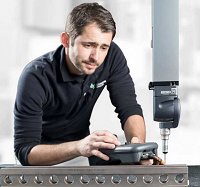The Difference Between Calibration and Certification
04.08.2017
Two of the most often confused terms among users of metrology equipment are "Certification" and "Calibration". Not knowing the difference can cause headaches when it comes time to have your equipment's yearly....wait...do I need a certification or a calibration? As many have discovered, the terms are not interchangeable, even though they are often used interchangeably.
Two of the most often confused terms among users of metrology equipment are "Certification" and "Calibration". Not knowing the difference can cause headaches when it comes time to have your equipment's yearly....wait...do I need a certification or a calibration? As many have discovered, the terms are not interchangeable, even though they are often used interchangeably.
 For the purposes of this discussion, we will be describing dimensional metrology industry standard practices-- we are not attempting to rewrite or reinterpret the ISO standards, or debate the academic meaning of the word Calibration. (if you're interested, there is a good discussion of that in this ASQ article). The purpose of this article is to describe what you should get when you ask for one or the other.
For the purposes of this discussion, we will be describing dimensional metrology industry standard practices-- we are not attempting to rewrite or reinterpret the ISO standards, or debate the academic meaning of the word Calibration. (if you're interested, there is a good discussion of that in this ASQ article). The purpose of this article is to describe what you should get when you ask for one or the other.
Certification
A Certification, whether it is on a measuring arm, a CMM, or a laser tracker, is the process of verifying that the machine in question is performing within it's stated specifications. Some kind of a reference artifact such as scale bar is usually used for this purpose. The process of getting to a "Certification" (the end result) is often referred to as "Verification". As in, "I performed a verification to achieve the certification of the machine". So where verification is the process, the certification is the end result. “My tests certify this machine is within specifications.”
Some types of machines offer the ability for companies to perform verification procedures themselves, and thus do a form of self-certification. The ROMER Absolute Arm offers a NIST-traceable length bar that can be used for a quick check to see if the machine is within specifications. Various "health check" devices for bridge CMMs have also been sold over the years for the same purpose.
While a self-certification is worthwhile as an interim check to ensure that the machine continues to hold spec, most companies’ quality plans require a third party certification at specified intervals (often 1 year). A third party certification gives extra confidence because the 3rd party company technicians will have better procedures, equipment and training to perform the certification. For example, Hexagon Manufacturing Intelligence factory certifications for portable measuring arms and bridge CMMs follow a complete set of standardized procedures and often take an entire day.
If an interim check or a yearly check shows that the machine is not performing within its stated specifications, it cannot be certified. Adjustments to the machine must be made in order for the machine to be able to be certified to specifications. This (in the industry) is referred to as a calibration.
Calibration
According to the prior discussion, if the verification procedures conclude the machine is not within spec, it cannot be certified as within spec, and something must be done to adjust it. This is referred to as a Calibration, and involves extra time, equipment, and expertise.
It is generally not advisable or even possible to calibrate your metrology equipment yourself. It’s a task best left to the experts that do it day in and day out, and have the proper training, procedures, and equipment to do the job right. Hexagon Manufacturing Intelligence maintains ISO 17025 Accreditation for field and lab work demonstrating competence in Calibration, which means that even we’ve been certified by a third party.
So the process of calibration involves bringing in a third party to make adjustments to your machine so that it can once again pass a certification that it is within spec.













































